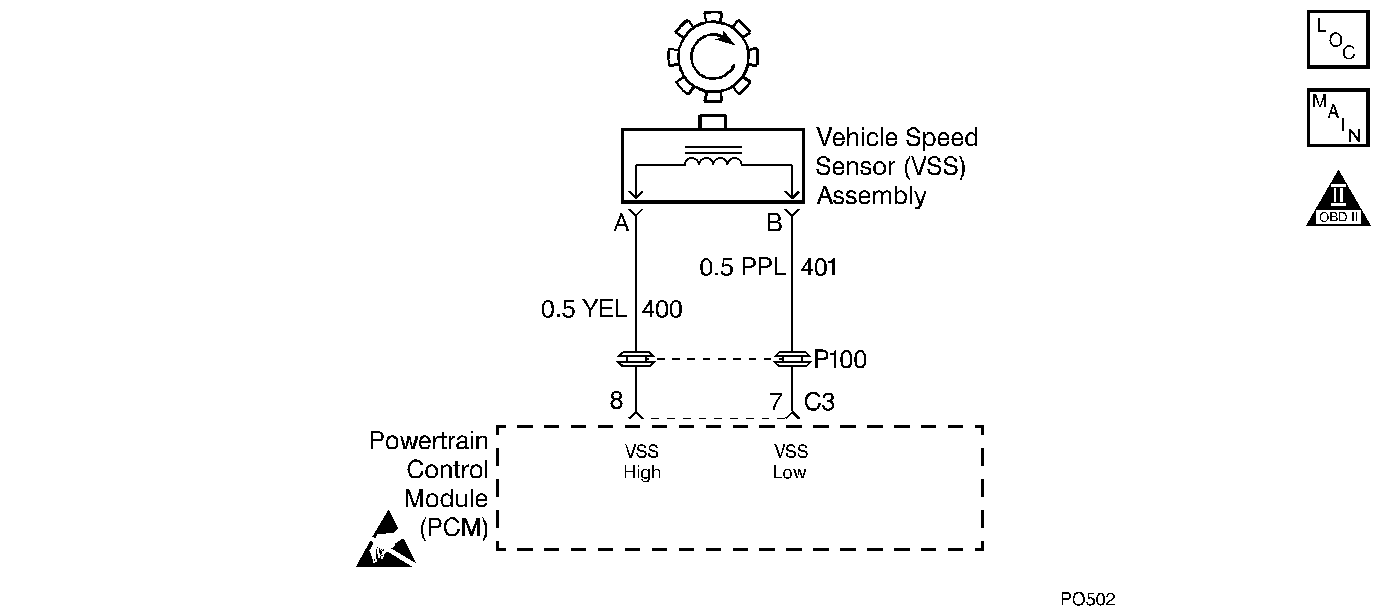
Circuit Description
Vehicle speed is provided to the Powertrain Control Module (PCM) by the Vehicle Speed Sensor Assembly (VSS Assy.), which is a Permanent Magnet (PM) generator mounted to the transmission case. The PM generator produces an AC voltage as the transmission's speed sensor rotor teeth pass in front of the sensor's magnet. The AC voltage level increases as the speed of the vehicle increases. The PCM converts the AC voltage into a digital signal. The PCM uses the signal to calculate the vehicle speed, and when to apply the Torque Converter Clutch (TCC).
When the PCM detects a low vehicle speed and there is a high engine speed in a drive range, then DTC P0502 sets. DTC P0502 is a type B DTC.
Conditions for Setting the DTC
| • | No MAP DTCs P0107 or P0108 |
| • | No TP DTCs P0122 or P0123 |
| • | The transmission is in a drive range. |
| • | The TP angle is 18-50%. |
| • | The engine vacuum is 0-30 kPa. |
| • | The engine speed is 2950-4800 RPM. |
| • | The vehicle speed is 3.2 km/h (2 mph), or less. |
| • | All of the above conditions are met for two seconds. |
Action Taken When the DTC Sets
The PCM illuminates the Malfunction Indicator Lamp (MIL), after two consecutive trips with a failure reported.
Conditions for Clearing the MIL/DTC
| • | The PCM turns OFF the MIL after three consecutive ignition cycles without a failure reported. |
| • | A scan tool can clear the DTC from the PCM history. The PCM clears the DTC from the PCM history if the vehicle completes 40 warm-up cycles without a failure reported. |
Diagnostic Aids
| • | Inspect for Electromagnetic Interferences (EMI) induced on circuit 400 and 401 by an improperly routed harness. |
| • | Inspect the wiring for poor electrical connections at the PCM. Inspect the wiring for poor electrical connections at the VSS Assy. Look for the following conditions: |
| - | A bent terminal |
| - | A backed out terminal |
| - | A damaged terminal |
| - | Poor terminal tension |
| - | A chafed wire |
| - | A broken wire inside the insulation |
| • | When diagnosing for an intermittent short or open condition, massage the wiring harness while watching the test equipment for a change. |
Test Description
The numbers below refer to the Step numbers on the diagnostic table.
-
This step inspects for a vehicle speed signal.
-
This step tests for AC voltage from the VSS Assy. at the PCM.
-
This step measures the VSS Assy. resistance. If the resistance is too high or too low, the VSS Assy. must be replaced.
-
The signal voltage on circuit 400 must be greater than 4.5 volts.
-
This step verifies that the PCM has the correct, or latest, calibration.
-
This step tests for an open on circuit 401.
-
Replace the PCM only after you have completed the preceding diagnostic steps.
Step | Action | Value(s) | Yes | No |
|---|---|---|---|---|
1 | Was the Powertrain On-Board Diagnostic (OBD) System Check performed? | -- | ||
2 |
Notice: Ensure that the battery is fully charged. An under charged battery may cause incorrect test readings.
Important: Before clearing the DTCs, use the scan tool in order to record the Freeze Frame and Failure Records for reference. The Clear Info function will erase the data. Notice: Support the lower control arms in the normal horizontal position in order to avoid damage to the drive axles. Do not operate the vehicle in gear with the wheels hanging down at full travel. With the drive wheels rotating, does the transmission output speed increase when the wheel speed increases? | -- | Go to Diagnostic Aids | |
3 |
Is the voltage greater than the specified value? | 0.5V AC | ||
4 | Connect an ohmmeter from terminal C3-07 to terminal C3-08 of the PCM connector. Is the resistance within the specified range? | 139-376ohms | ||
5 |
Is the resistance equal or less than the specified value? | 0.5ohms | ||
6 |
Is the voltage greater than the specified value? | 4.5V AC | ||
7 |
Refer to Troubleshooting Procedures, Section 8. Did you find and correct the condition? | -- | ||
8 | Connect a test lamp from battery power (B+) to terminal B of the VSS Assy. harness connector. Is the test lamp ON? | -- | ||
9 |
Refer to the current Service Bulletin. Is the calibration correct for the vehicle? | -- | ||
10 | Update the PCM with the latest calibration. Refer to Powertrain Control Module/EEPROM Replacement/Programming , Section 6. Is the calibration update complete? | -- | -- | |
11 |
Refer to Troubleshooting Procedures, Section 8. Did you find and correct the condition? | -- | -- | |
12 | Replace the VSS Assy. Refer to Vehicle Speed Sensor Assembly Replacement, in On-Vehicle Service. Is the replacement complete? | -- | -- | |
13 | Replace the PCM. Refer to Powertrain Control Module/EEPROM Replacement/Programming , Section 6. Is the replacement complete? | -- | -- | |
14 | In order to verify your repair, perform the following procedure:
Has the test run and passed? | -- | System OK |
